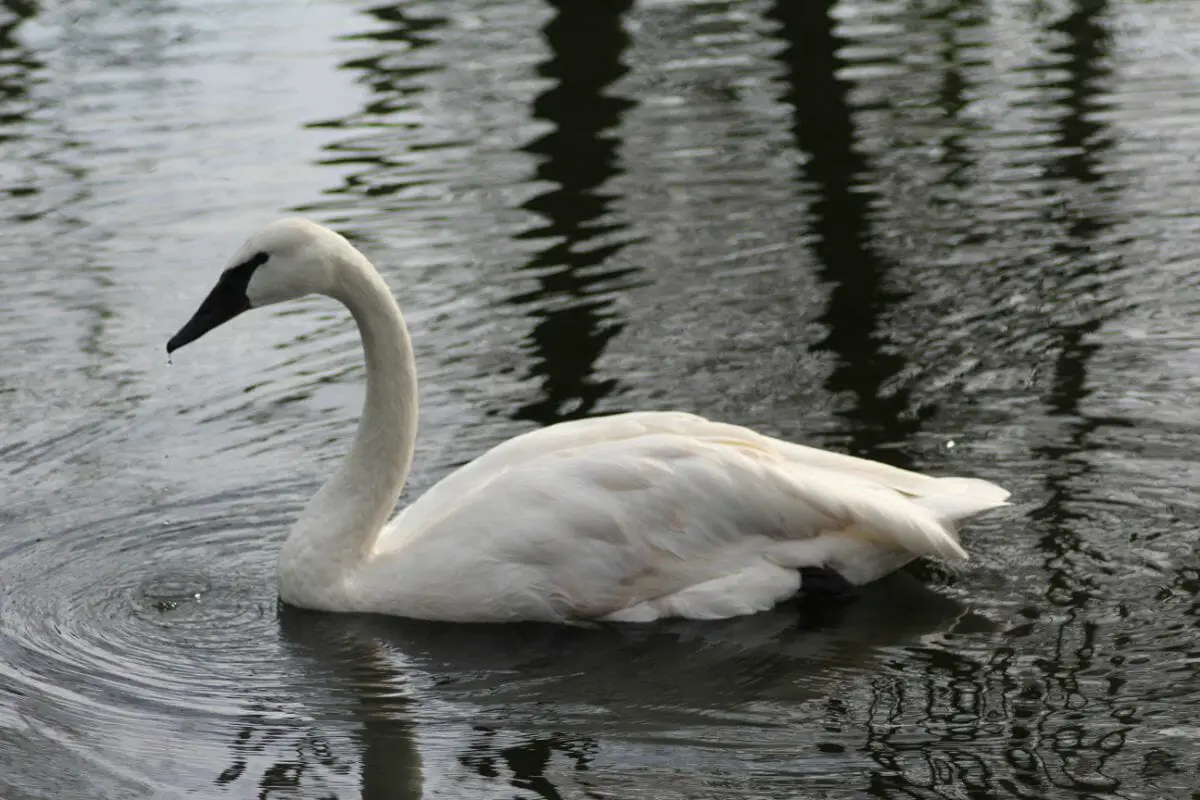Swans are one of the most elegant animals there are, gliding over the top of the water with their beautiful feathers.
However, when you picture one, you probably just picture a plain white swan.

It might surprise you to know that there are actually a variety of different swans in existence, and they’re not even all white.
In our informative guide below, you’ll find out about each type of swan.
There are 7 in existence: the trumpeter swan, Bewick’s swan, black swan, tundra swan, whooper swan, black-necked swan, and the mute swan.
All are relatively similar in their bills and build, though they differ in small and interesting ways.
The Trumpeter Swan
These white swans weigh in at around 25 pounds, about the same as the mute swan which we’ll get into later.
They are certainly large, which is partly down to their impressive wingspan, stretching between 7 and 8 feet wide.
Trumpeter swans like to be found in shallow waters, because the low depths of a few feet make it easier for them to dip their heads under the water and forage for plants.
You might think that the large size would make shallower waters uninhabitable for them, but it is quite the opposite.
As for the plants thy forage, these include underwater aquatic plant life such as duckweed and pondweed. During the summer time, they might forage algae too.
During the winter time, they go for more diverse selections, like potatoes and blueberries, on top of plants like ryegrass.
Although there are more trumpeter swans in Canada and Alaska, the bird is native to North America, and can be found in many places across it.
Though they were at one point an endangered species, down to hunting and being invaded by mute swans, they have been deliberately conserved over the previous few decades and are beginning to have their numbers rise once more. To spot one, look for large swans that have a straight, fully black bill.
Bewick’s Swan
Also known as the whistling swan, these are among the smallest swans, weighing just 14 pounds usually.
On top of that, their wingspan is moderate, stretching between 5 and 6 feet.

As for location, it all depends on time of year. In the winter, they are usually in the UK.
In the summer, however, they will be found in Siberia, where they migrate during the hot period.
All year around, though, is where you’ll find them in some parts of Alaska.
When they’re in these countries, they will often be found in open water, or even in marshland and fields for crops.
These habitat spots revolve around feeding. From the fields, they feed on potatoes and wheat, while on the open water they forage for water-borne insects.
Black Swan
These are distinctive and admittedly stylish swans, completely jet black but with a bold red bill.
The red contrasts so strikingly with the black body, making for a memorable swan.
Additionally, their feathers have thin white boundaries, adding depth to the look.
The black swan can weigh up to 20 pounds, but it is fairly medium sized.
On top of that, their wingspan can reach up to 6 and a half feet long.
You will find them in Australia, Europe, and North America – though they are only native to the latter.
They get to these other places in the world because humans move them around a lot.
You may think this nice, allowing more to see them, but they are deemed an invasive species and can hurt the ecosystems of countries that they are not native to.
While in these locations, you will often find them in smaller spots of water, rather than wide open ponds and lakes.
These somewhat suit their moderate size, though it might make them harder to find and see.
Tundra Swan
These may look similar to the trumpeter swans, but they are actually smaller, weighing around 15 pounds usually.
On top of that, they have yellow spots on their bills, which makes it even easier to tell them apart. As for their wingspan, it stretches around 5 feet wide.
Like the Bewick’s swan, these are known to migrate, though the locations are different.
They stay in the Arctic in the summer, before moving to the north of America in the winter, including Canada.

In America, you can find them on large bodies of water, where they try to forage for food: crayfish, aquatic plant tubers, and wild grasses. They’ll venture further for potatoes, too.
Whooper Swan
These are large and heavy, weighing almost 24 pounds, with a wingspan up to 9 feet wide.
Their bill is yellow near the base, while black elsewhere. You will often find them in Europe and the east of Asia in the winter.
While there, they like to stay in wetlands, or other open waters like lakes.
They forage for vegetation (pondweed, grasses, and so on), insects, and even fish sometimes – though only small ones.
Black-Necked Swan
You can guess that these have a black neck, while the rest of them is white.
They are relatively small, weighing only 15 pounds and with a maximum wingspan of 5.5 feet.
They are very popular around South America, but move north during the winter.
There, they feed on grains and crops at land, or forage for underwater plants and algae when in open bodies of water.
Mute Swan
The most well-known swans, these are native to Europe but exist in the US too.
Up to 26 pounds in weight, they are sizable and often overtake other waterfowl to food and shelter.
When they do, they go for all kinds of water and fields, and spend their time feeding on plants and crops.
Final Thoughts
There are seven different types of swan, and you can now identify them all easily!









